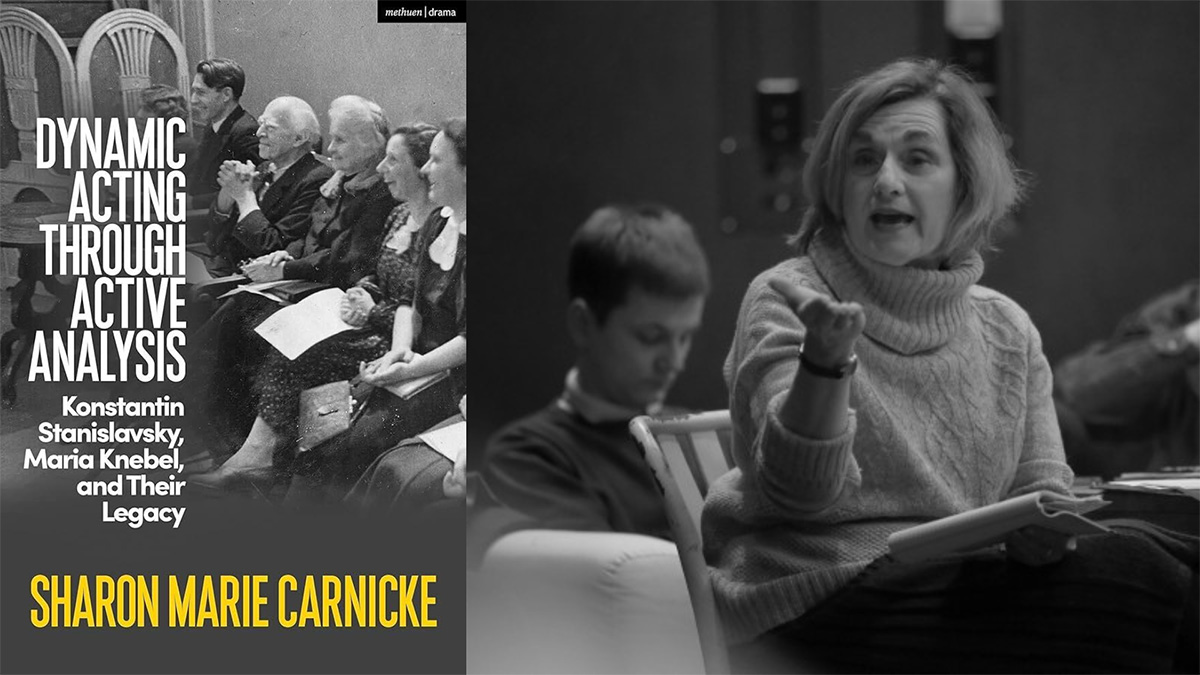
"Dynamic Acting Through Active Analysis" by Sharon Marie Carnicke.
At the beginning of Dynamic Acting Through Active Analysis (Methuen Drama), Professor Sharon Marie Carnicke’s new book on Stanislavsky’s legacy, the great Russian actor and educator finds himself in a changed world. A few days following a disastrous speech that upset the Soviet government’s political sensibilities, he finds himself in a too-tight costume, delivering a final performance of Vershinin in Three Sisters before suffering an immense heart attack. It was to be the end of his acting career—but only the beginning of a new chapter in his life as an artist and educator.
Professor Carnicke’s book is an entirely unique creation, capturing both the historical context and the spirit and practice of Active Analysis. Part history, part theory and part intensive course on Stanislavsky’s system for modern actors, the book will find an eager audience among artists and scholars alike.
“I feel very lucky to have a foot both in acting and as a scholar,” Professor Carnicke said. Recalling the writing process of her classic book Stanislavsky in Focus (Routledge Theatre Classics), she said: “I understood things the way Russians would, and also the way American actors would, and that made me unique. I think that’s why my first work on Stanislavsky has had such a big impact on the field.”
Professor Carnicke is not only one of the foremost scholars on Stanislavsky in the world; she is an active practitioner of Stanislavsky’s Active Analysis, his last, most innovative technique.
A bridge between Stanislavsky and today
The first half of the book grounds Stanislavsky’s artistic work in history. Developed amidst Stalin’s reign of terror in the Soviet Union, the book focuses on both Stanislavsky and his protégé Maria Knebel, a figure that has until now gone overlooked in theatre studies. As Stanislavsky’s friends and colleagues were being tried, imprisoned and executed over artistic decisions, Stanislavsky found himself more and more heavily surveilled and censored by the Soviet government. Of particular interest is Professor Carnicke’s examination of Knebel, whose instincts and political savvy kept Stanislavsky’s techniques alive through three generations of Soviet turmoil.
“She becomes, for me, a bridge between Stanislavsky and today,” Professor Carnicke said. “She kept his traditions alive, and especially his last experiments. She retained them through the worst of the Soviet years until she could start writing about them in the ’60s when there was a thaw.”
While the Soviet government was relentless in attempts to censor Stanislavsky’s thoughts and work, Knebel used her tremendous instincts and political savvy to preserve his work in a way that would both satisfy the government while staying true to Stanislavsky’s philosophy and intentions. “[Knebel] was much better at walking the tightrope, and as a result, she kept the tradition alive, even though there were a lot of forces trying to suppress it,” Professor Carnicke said. “She negotiates the censors and still finds ways to speak her truth. She was much more politically savvy [than Stanislavsky].”

A life-and-death matter
The second half of the book jumps to the present and allows the reader to experience an intensive course in Active Analysis with Professor Carnicke. The book invites readers to observe a fictionalized group of actors as they use Stanislavsky’s method to navigate works by Shakespeare, Chekhov and even an entirely new play—presented for the first time in print—by the playwright Joan Eyles Johnson.
“I used Chekhov and Shakespeare because they’re still the most produced playwrights in the world, but I didn’t want to stop there,” Professor Carnicke said. “Active Analysis is for everything. It’s for new plays, it’s for devised plays, it’s for film work and new media. [Working with Johnson’s play] really allowed me to talk about themes, how they develop and change across the play, with a brand new work that people won’t know.”
The end result is a marvelous work that will find an audience both with scholars of Stanislavsky while still being accessible to modern actors who wish to benefit from his teachings. Active Analysis prioritizes authentic reaction, improvisation and physical movement to give rich, nuanced performances. Professor Carnicke’s book shows that, far from being a dry historical method that died with Stanislavsky, Active Analysis is a dynamic system that has evolved and responded to new material in an authentic way.
“We have to look at the whole of Stanislavsky to see how important he can be today,” Professor Carnicke said. “We have to look at what’s left out of the record as much as what’s in it. Stanislavsky was really an actor, and he was dealing with what all of us deal with every time we get up on stage with a piece of material that challenges us. I think that’s why his teachings remain so relevant.”
Professor Carnicke hopes to bring Stanislavsky’s history and teachings to life for a new generation of scholars and actors. The history and use of Active Analysis come alive through the vivid historical writing and the moment-by-moment accounts of the method being used in a modern context, providing both a solid contextual understanding and a vivid demonstration for modern actors and scholars alike.
“I write accessibly so that actors can follow the scholarship and make it their own, but I also wanted to bring a sense of why the work matters,” Professor Carnicke said. “I couldn’t leave the history out because people gave their lives for art in the Soviet Union. Art can be a life-or-death matter, and I feel like people in our country and in our times should have a sense of that.”